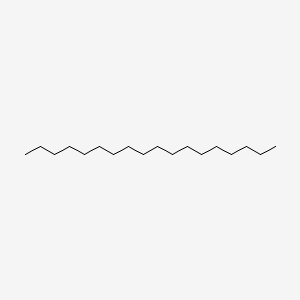| MeSH term | MeSH ID | Detail |
|---|---|---|
| Pancreatic Neoplasms | D010190 | 77 associated lipids |
| Celiac Disease | D002446 | 16 associated lipids |
| Bronchiectasis | D001987 | 7 associated lipids |
Octadecane
Octadecane is a lipid of Fatty Acyls (FA) class. The related lipids are Fatty Acids, erucic acid, stearic acid, palmitoleic acid and 9-tetradecenoic acid.
Cross Reference
Introduction
To understand associated biological information of Octadecane, we collected biological information of abnormalities, associated pathways, cellular/molecular locations, biological functions, related genes/proteins, lipids and common seen animal/experimental models with organized paragraphs from literatures.
What diseases are associated with Octadecane?
There are no associated biomedical information in the current reference collection.
Possible diseases from mapped MeSH terms on references
We collected disease MeSH terms mapped to the references associated with Octadecane
PubChem Associated disorders and diseases
What pathways are associated with Octadecane
There are no associated biomedical information in the current reference collection.
PubChem Biomolecular Interactions and Pathways
Link to PubChem Biomolecular Interactions and PathwaysWhat cellular locations are associated with Octadecane?
There are no associated biomedical information in the current reference collection.
What functions are associated with Octadecane?
There are no associated biomedical information in the current reference collection.
What lipids are associated with Octadecane?
Related references are published most in these journals:
| Lipid concept | Cross reference | Weighted score | Related literatures |
|---|
What genes are associated with Octadecane?
There are no associated biomedical information in the current reference collection.
What common seen animal models are associated with Octadecane?
There are no associated biomedical information in the current reference collection.
NCBI Entrez Crosslinks
All references with Octadecane
Download all related citations| Authors | Title | Published | Journal | PubMed Link |
|---|---|---|---|---|
| Zhou X et al. | Quantitative proteomics analysis of proteins involved in alkane uptake comparing the profiling of Pseudomonas aeruginosa SJTD-1 in response to n-octadecane and n-hexadecane. | 2017 | PLoS ONE | pmid:28662172 |
| Jiao S et al. | Microbial succession in response to pollutants in batch-enrichment culture. | 2016 | Sci Rep | pmid:26905741 |
| Ianieva OD | Biosurfactant-producing yeasts isolated from flowering plants and bees. | 2013 Jul-Aug | Mikrobiol. Z. | pmid:24006785 |
| Hua F et al. | Trans-membrane transport of n-octadecane by Pseudomonas sp. DG17. | 2013 | J. Microbiol. | pmid:24385357 |
| Moradi M et al. | Comparison of headspace solid-phase microextraction, headspace single-drop microextraction and hydrodistillation for chemical screening of volatiles in Myrtus communis L. | 2012 Jul-Aug | Phytochem Anal | pmid:22069217 |
| Hyldgaard M et al. | Essential oils in food preservation: mode of action, synergies, and interactions with food matrix components. | 2012 | Front Microbiol | pmid:22291693 |
| Mekhail GM et al. | Anticancer effect of atorvastatin nanostructured polymeric micelles based on stearyl-grafted chitosan. | 2012 | Int. J. Biol. Macromol. | pmid:22652220 |
| Ryu NH et al. | A hexane fraction of guava Leaves (Psidium guajava L.) induces anticancer activity by suppressing AKT/mammalian target of rapamycin/ribosomal p70 S6 kinase in human prostate cancer cells. | 2012 | J Med Food | pmid:22280146 |
| Anko M et al. | Influence of stearyl and trifluoromethylquinoline modifications of the cell penetrating peptide TP10 on its interaction with a lipid membrane. | 2012 | Biochim. Biophys. Acta | pmid:22240008 |
| Xu L et al. | Analysis of saikosaponins in rat plasma by anionic adducts-based liquid chromatography tandem mass spectrometry method. | 2012 | Biomed. Chromatogr. | pmid:21993856 |
